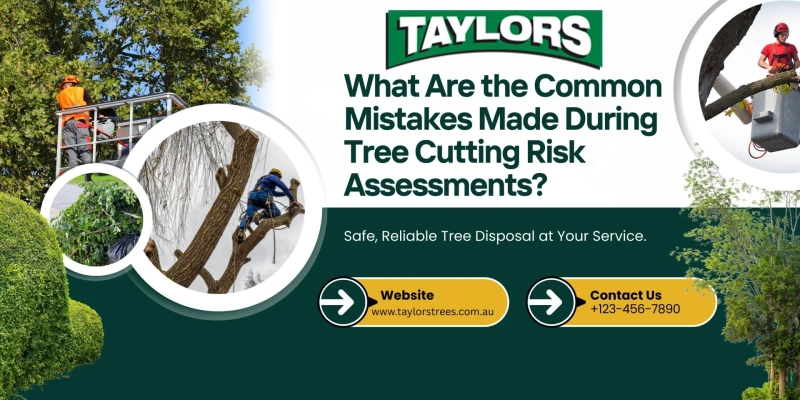Introduction
Cutting down a tree might seem straightforward, but without a proper tree cutting risk assessment, it can quickly turn into a dangerous and costly job. In Australia, where trees like eucalyptus, gum, and paperbark can be large and unpredictable, assessing risks before starting is essential for safety, compliance, and efficiency.
Unfortunately, many homeowners – and sometimes even contractors – make avoidable mistakes during the risk assessment stage. These errors can lead to property damage, injury, and legal trouble.
Below, we’ll look at the most common mistakes made during tree cutting risk assessments and how you can avoid them by following best practices or hiring a professional like Taylors Tree and Stump Removal.
1. Skipping Local Council Permits
One of the most common mistakes is starting tree cutting without checking council rules. Many councils across Australia protect certain tree species, and removing them without permission can lead to significant fines.
How to avoid it:
- Review your local council’s tree protection laws.
- Seek advice from an arborist familiar with local regulations.
- Apply for necessary permits before any cutting begins.
2. Ignoring Tree Health and Stability
A proper tree cutting risk assessment involves checking the tree’s health and structural integrity. Diseased, dead, or unstable trees can behave unpredictably when cut, posing serious hazards.
Signs to watch for:
- Hollow trunks or large cracks
- Dead branches or peeling bark
- Visible fungal growth
- Leaning structure or unstable roots
Professional arborists can detect hidden weaknesses and choose the safest removal method.
3. Overlooking Power Lines and Utility Hazards
Trees growing near power lines present an extra level of danger. Attempting to cut without proper precautions can cause electrocution, blackouts, or fires.
Best practice:
- Identify all nearby power lines and underground services.
- Contact your energy provider for safety guidelines.
- Leave high-voltage work to qualified professionals.
4. Using the Wrong Equipment
Using a blunt chainsaw, unstable ladder, or the wrong cutting tools increases the risk of accidents. Many DIY jobs fail because equipment is not suited to the tree’s size, location, or condition.
How to do it right:
- Use well-maintained, industry-approved tools.
- Wear full safety gear, including helmet, gloves, and harness.
- For large trees, use professional machinery such as rigging systems and pole saws.
5. Misjudging Fall Direction
Accurately predicting where a tree or large branch will fall is critical. A wrong calculation can damage property or cause injury.
Factors to assess:
- Tree height and lean direction
- Weight distribution of branches
- Wind conditions and ground slope
Professionals use ropes, pulleys, and controlled cutting techniques to guide the fall safely.
6. Cutting in Unsafe Weather
Strong winds or wet conditions make tree cutting unpredictable and dangerous. Many accidents occur because people assume the job will be quick despite poor weather.
Safety tip:
- Check the Bureau of Meteorology (BOM) forecast.
- Avoid cutting during storms, high winds, or heavy rain.
- Schedule work for calm, dry conditions.
7. Disturbing Wildlife Habitats
Australian trees often house possums, birds, and other wildlife. Cutting without checking for nests or hollows can harm animals and breach environmental laws.
What to do:
- Look for nesting activity or hollows before cutting.
- Contact wildlife rescue if animals are present.
- Follow ethical and legal tree removal practices.
8. Ignoring Ground Hazards
It’s not just what’s above that matters – the ground conditions play a huge role in safety. Uneven surfaces, slopes, and debris can cause falls or affect equipment stability.
Precautions:
- Clear the work area of obstacles.
- Use stable platforms for ladders and machinery.
- Set up exclusion zones to protect bystanders.
9. Poor Team Communication
If multiple people are working together, unclear communication can lead to accidents. Without a shared plan, someone could end up in the fall zone.
How to improve:
- Conduct a safety briefing before starting.
- Use clear hand signals or two-way radios.
- Assign specific roles to each team member.
10. Taking on High-Risk Jobs Without Expertise
Many homeowners underestimate the complexity of certain cuts. Large, leaning, or damaged trees require advanced techniques and specialised equipment.
Why hire a professional:
- Certified arborists have the training, insurance, and tools for safe work.
- Jobs are completed faster and with minimal risk.
- You avoid costly mistakes and potential injuries.
Why Choose Taylors Tree and Stump Removal
At Taylors Tree and Stump Removal, safety is our top priority. We conduct detailed tree cutting risk assessments to ensure every job meets Australian safety standards and local council regulations.
We offer:
- Professional arborist inspections
- Permit application assistance
- Safe tree felling and pruning
- Stump grinding and site clean-up
Our team combines experience, equipment, and care to get the job done right the first time.
Final Thoughts
A tree cutting risk assessment is more than just a checklist – it’s the key to protecting people, property, and wildlife. Avoiding the mistakes above can save you from accidents, fines, and unnecessary costs.
If you want peace of mind and professional service, contact Taylors Tree and Stump Removal today for a free, no-obligation quote.


